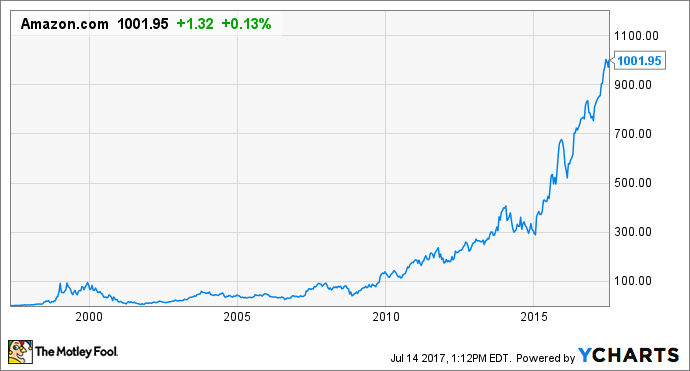Jeff Bezos founded Amazon.com (AMZN 1.30%) in his garage in 1994 as an online bookstore, during the early days of online shopping. I remember ordering my first college textbooks on Amazon in 2000, and being the only one of my friends to do so, as e-commerce was still a relatively new concept. Amazon went public in 1997 and has since evolved into one of the world's largest retailers.
If you've ever wondered how much money you would have made by getting in on the ground floor of Amazon, here's a look back at how far the stock has climbed since its IPO and how much a hypothetical $10,000 investment would be worth today. And if you missed the boat on Amazon, we'll also look at a few strategies you can use to identify the Amazons of tomorrow.

How Amazon looked in the beginning. Image source: Amazon.com.
How much was Amazon stock worth in 1997?
Just over 20 years ago, in May 1997, Amazon's stock went public at $18 per share. The stock split three times during the dot-com boom, with a total division of 12-for-1. So if you're comparing it with today's share price of just over $1,000, Amazon.com traded for a split-adjusted $1.50 at its IPO in 1997.
At the company's $1,002 share price as I write, Amazon's stock is worth 668 times its IPO price. That means if you had invested $10,000 into Amazon's IPO and had held on to your shares for the past 20 or so years, your investment would be worth nearly $6.7 million today. That translates to a roughly 38% annualized return on your investment, a remarkable level of performance over a period of two decades.
Amazon's founder is now the world's second richest person
Bezos still owns 80.9 million shares of Amazon stock, which translates to a stake of just under 17% in the e-commerce giant. At the current share price, Bezos' stock is worth about $81.1 million.
Bezos' net worth is estimated to be $85.1 billion, putting Bezos just behind Bill Gates atop the list of the world's richest people.

Image source: Getty Images.
How to find the next Amazon
To be perfectly clear, there is no guaranteed formula to find the next home-run stock. If it were that easy to determine what the next stock to have an Amazon-like run will be, everyone would be pouring money into it.
Colleagues of mine have written recently about other stocks they think could have Amazon-like potential, but more important than their picks is their reasoning behind them. There are a few things to look for that can help you narrow down your own search. First, and perhaps most important, is to look for companies that are transforming industries or have the potential to do so. For example, one of my favorite potential home-run stocks, and one that I own, is Square (NYSE: SQ), which I believe has an opportunity to change the payment-processing industry all over the world.
How to invest in stocks with home-run potential
There's nothing wrong with doing some speculating on stocks that are in the early stages of potentially massive returns. I have a handful of stocks like this in my own portfolio.
However, keep in mind that hindsight is 20/20. Sure, if you would have invested an entire $100,000 stock portfolio in Amazon's IPO, you'd have nearly $70 million today. On the other hand, if you'd done the same with many other "high-potential" dot-com companies in those days, you could have lost everything.
The point is that no company with Amazon-like potential is low-risk, so be sure to invest with that knowledge in mind. I mentioned that I invest in Square for its long-term potential, but it makes up only about 1% of my portfolio, so if things go wrong, it won't be devastating.






